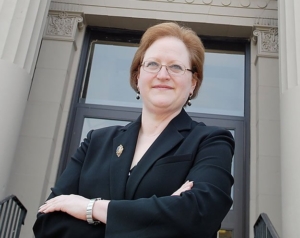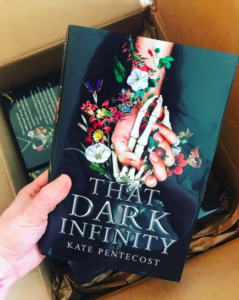Ethel’s Song: An Interview with Barbara Krasner

 4. Tell us a bit about you. What makes you tick as an author?
4. Tell us a bit about you. What makes you tick as an author?
 4. Tell us a bit about you. What makes you tick as an author?
4. Tell us a bit about you. What makes you tick as an author?Hi! I’m Ceredwyn. You may also know me as Kate Pentecost, VCFA alumnx and author of Elysium Girls and That Dark Infinity. I’m the new Program Assistant for VCFA’s Writing for Children and Young Adults program, and I’m thrilled to be taking over the Wild Things blog, the various VCFA social media accounts, and helping with residency. But today I want to talk about writing, death, and VCFA.

The first time I considered dying was also the first time I considered the alternative: living forever. I was eight years old and I’d just come back from a church service that heavily featured the idea of eternal life, how when we got to Heaven, there would be no end. I contemplated that. The idea, however terrifying, lodged in my brain and would stay there for what seems so far to be my entire life.
Four years later, when I was twelve, a character appeared in my mind one day and decided to stay there. He was a tall young man of around nineteen or twenty, tall and lean, almost gaunt, with olive skin, dark eyes, and black hair that touched his shoulders. He liked the color black, I knew, and was some sort of a solitary mercenary. A girl followed after that, with chin-length red hair she’d cut herself, wearing a man’s tunic and clearly out of place. Her name, I knew, ended with an “a” and went from Dahlia to Dara to eventually Flora. The young man’s name was much more difficult to find. And there in the year 2000, typing away ay my enormous, blocky desktop I set about penning what I concluded was the most epic of fantasies at 149 pages.
The original story was nothing spectacular. It was derivative (I was twelve!) and had little in the way of style (I was twelve!) and honestly was similar in tone to the Shrek films (again, I was twelve!,) but my life had a direction. I was going to be young adult fantasy author! I continued revising and submitting and getting rejections throughout high school and was accepted to the University of Houston’s Creative Writing program.
Then life became hard.
During my first semester of college in Houston, I was sexually assaulted off-campus. A month later, my grandmother, whom I’d spent almost every day with growing up, died after a stroke and I wasn’t able to be there at her deathbed. Suddenly, I found myself dealing with two very different types of grief: the major but inevitable grief of a loved one dying and the grief for oneself and one’s body that accompanies PTSD, and which I wouldn’t admit to myself I had. I failed three classes in my major that semester as I insisted that nothing had really happened and that I was just being lazy or weak.
Still, it hurt so terribly. It hurt all day and the only relief I got, in sleep, would begin all over again whenever I woke the following day. Desperate to heal from this unending cycle, but afraid to tell anyone what had happened, I did the only thing I knew how to do: I tried to write my way out of it, to escape into the fun fantasy world I’d created and loved so much. But a writer can never divorce oneself from one’s circumstances.
The story changed from underneath me, grew darker, even as I was accepted to VCFA’s WCYA program, my dream writing program. My second semester advisor, April Lurie, encouraged me to lean into the darkness and stop trying to make the story fit what I wanted it to be but couldn’t be anymore. I allowed a darkness to fall over the book. The appropriate darkness. I scrapped what I’d written and rewrote it, starting over seven times before April told me that it felt authentic.
In this new version, Flora came to share my story of survival of sexual assault. As for the male character, I wanted my readers to feel what I felt through him somehow, that cycle of pain and grief that resets every morning and never seems to end. And as I let myself confront that and examine it, the character finally began to speak to me authentically. He had a curse, I realized. A curse that hinged on, not quite immortality, not quite death, but the worst parts of both. Something that caught him in an endless cycle of death and resurrection but never peace or permanence. That was his quiet yearning, I learned, and finally, as I studied poetry, he told me his name.
I am Lazarus, come from the dead/ Come back to tell you all. I shall tell you all.
– T.S. Eliot, The Lovesong of J. Alfred PrufrockDying
Is an art, like everything else.
I do it exceptionally well.I do it so it feels like hell.
I do it so it feels real.
I guess you could say I’ve a call.
– Lady Lazarus, Sylvia Plath
I studied craft and characterization, drafted chapter after chapter, packet after packet, and as I did so I threw myself also into studying death, to make it feel real, to understand what it would feel like to die. I studied grief, depression, PTSD. I learned that when you die your hunger goes first, then your smell and taste, followed by your sight, which dims as you slowly lose sensation and finally hearing. I threw myself into understanding this strange character who had always been with me and who was so important to me for some reason. But it is to the other character, Flora, that I owe the most.

As I learned more about her with Mark, April, Susan, and Louise, I realized that since her struggle was my own, I had to understand how to make myself better to help her reach the healing she needed by the end of the book. I sought therapy, worked as a crisis counselor for RAINN, examined my sense of guilt about what had happened, and eventually was able to forgive myself and ultimately heal. Even death, which I had always feared, I came to understand and to accept.
I found that what I was learning at VCFA helped me to deeply study these characters whom I realized eventually were parts of me, and thus study myself. Just as the characters help each other to heal in the book I was writing, what I’d learned about grief from studying death for Lazarus helped me understand how to help heal Flora. Both of them (and my advisors’ guidance) helped me to heal myself through the power of my own creation.
This book, That Dark Infinity, has a special place in that it is the book of my childhood, my adolescence, and my growth into a healed adult. It became my creative thesis and was the book that got me my agent, Sara Crowe, who is fantastic, and it was published in October 2021.
A lot of this I owe to VCFA and my advisors and classmates, which, I suppose, is one of the reasons I’m so excited to be able to work here. But I wanted to share the greatest wisdom, writerly or otherwise that I have been able to learn so far: wherever you are, whatever you’re going through, look your situation in the face, come to understand it, and keep going.
best Running shoes brand | Supreme x Nike Air Force 1 Low ‘Box Logo – White’ — Ietp
Best jordan Sneakers | Men's Footwear
latest Running | Women’s Nike Air Force 1 Shadow trainers – Latest Releases , Ietp
Nike air jordan Sneakers | Nike Air Max 270
Running sneakers | Nike Shoes
Sports brands | Converse Chuck Taylor All Star Translucent – Women Shoes – 165609C
best shoes | Men’s shoes
This site uses cookies. By continuing to browse the site, you are agreeing to our use of cookies.
Learn moreOK